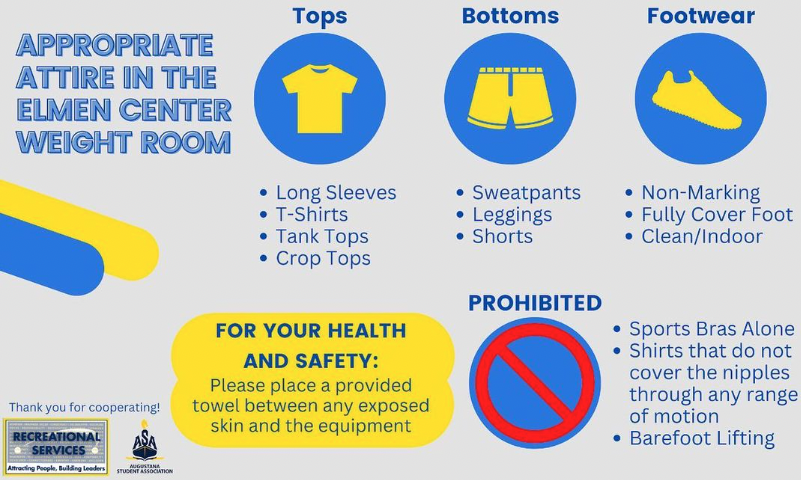Rec Services changes weight room dress code

Crop tops are now considered acceptable attire in the weight room according to Rec Service’s new policy.
Under the new policy, if a student wears a shirt that exposes a significant amount of skin, they will be required to use a towel between themselves and the equipment.
Mark Hecht, the director of Recreational Services, said concerns from students about “not being able to wear what they wanted to wear” prompted the dress code update.
The Augustana Student Association appointed a task force to create an updated dress code, and Hecht said he believes it addressed the necessary issues.
This past March, student workers at the weight room started enforcing the previous dress code. The enforcement was met with backlash from students who believed the policy unfairly targeted women.
On March 31, Augustana’s Feminist Equality Movement club organized a protest in response to the old dress code’s enforcement. Members of the FEM club made signs with phrases like “Don’t tell me what to wear” and “I’m sorry my midriff offends you.”
While crop tops will now be accepted as proper attire, sports bras are still prohibited.
“The task force did decide that the policy should continue to not allow sports bras as the original policy stated,” Hecht said.
The old dress code specified that the bottom of the shirt needs to touch the top of the waistline on shorts or pants, but the new policy includes crop tops as “appropriate attire.”
Hecht said he wanted all weight room users to feel comfortable with what people wear in the weight room but that Augustana has students of many different cultural backgrounds, something that he said creates “different cultural beliefs” in regard to clothing.
Hecht said that a main goal of the original dress code was to help minimize health risks.
“Proper attire plays a role in helping the equipment surface areas to last longer, and proper attire reduces the chance of skin disease transmission,” Hecht said.
Sophomore Madelyn Earhart said the updated dress code makes a lot more sense to her than banning crop tops.
“It would be one thing to wear a very small sports bra that’s like a bikini top,” Earhart said. “That’s obviously inappropriate for a gym setting, but it’s not the administration’s job to police what other people wear.”
Earhart said she understands the concern for cleanliness in the weight room.
“I understand people being concerned about sanitary issues,” Earhart said. “That’s even why people wear shower shoes.”
Many students had issues with the health and cleanliness aspects of the old dress code. Senior Sydney Hayes said she didn’t understand why Rec Services was taking issue with people’s stomachs being exposed.
“Tell me how my stomach spreads more bacteria than my hands,” Hayes said. “It gets wiped down anyway. At that point, you’re just reaching for any sort of backup to why this [old] dress code is important.”
While Hayes protested the original dress code, she said she feels more content with the updates.
“I think having to put a towel down if you are wearing a crop top is totally fine,” Hayes said.
Since towels will be used more frequently in the weight room, ASA approved $2,000 to go towards purchasing additional towels.
Hecht said he hopes this new dress code will satisfy students and their concerns about clothing freedom.
“Current ASA leadership has felt good about [the update] as I have interacted with them this fall,” Hecht said.
Some students, including Hayes, have said that the new dress code might not be completely foolproof.
“I think the new dress code has fixed a lot of issues, but I think there are still some issues [needing] to be resolved,” she said.
Junior Mary Christensen said she agrees with Hayes, as the new dress code could be ambiguous.
“The only problem I can point out with the dress code is the difficult line of when a crop top becomes considered a sports bra,” she said.
Despite the potential for confusion, Christensen said that changing the dress code was a necessary first step.
“The new dress code seems adequate,” Christensen said. “I do believe that by readjusting the dress code, the Elmen admitted to being too strict on students’ attire, especially in relation to the female body and skin exposure.”
While there may be issues with the new crop top policy, Hecht said that further discussion of the dress code is to be expected.
“We have agreed to revisit the policy this year to see how it is going and to discuss any feedback that we have received on it,” Hecht said.



